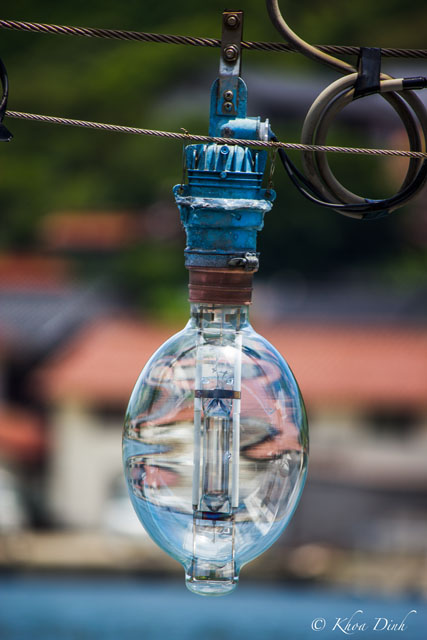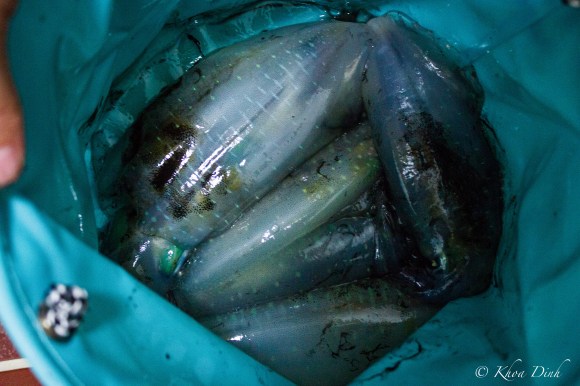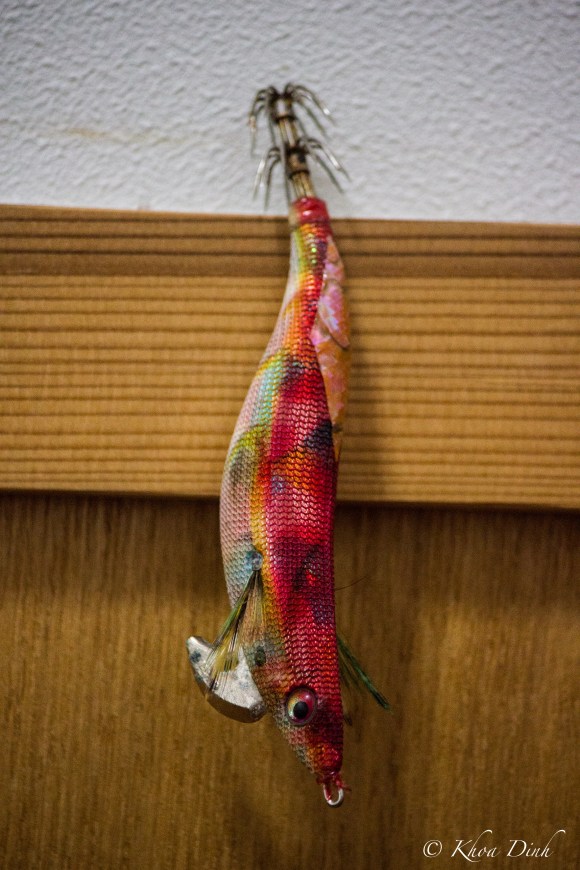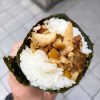 You, Me, And a Tanuki is a weekly featured blog run by Michelle, a Californian who is currently one of only two foreigners living in Chibu, a tiny fishing village on one of the Oki islands in Japan. Check back every Saturday for a new post or read more on her website here!
You, Me, And a Tanuki is a weekly featured blog run by Michelle, a Californian who is currently one of only two foreigners living in Chibu, a tiny fishing village on one of the Oki islands in Japan. Check back every Saturday for a new post or read more on her website here!
It’s squid fishing time in Chibu and when the waves aren’t too high, the horizon is sure to be speckled with the distant light of squid fishing vessels. Sometimes there are so many boats out at sea that it looks as if dawn is breaking.
Squid fishing is mostly done at night and each squid boat is equipped with large light bulbs that are used to attract squid to the boat.
^Close-up of the large light bulbs used on squid fishing vessels. The bright light attracts the squid.
In Chibu, you can also catch squid right off the side of the docks without using any lighting source. The haul isn’t as large compared to fishing out at sea, but many hobbyist fishermen in the area have brought in up to thirty squid in one outing.
One of my fishermen friends told me that squid always come in pairs. I guess they are romantic animals. It’s said that if you are able to catch the female first, the male will search for its mate around the vicinity of the boat, making for an easy catch. But if you catch the male first, the female will simply swim away and never look back. They say it’s best to catch the female first because you’re likely to get a second squid. I’m not sure if this is just an old wives’ tale (old fishermen’s tale?), but it’s an interesting story either way.
^A big bag o’ squid.
I’ve tried my hand at squid fishing off the docks near my house a few times. It was really hard for me to tell when I had a squid on the line. The lure is so light, there’s almost no drag when whipping it through the water and the squid only adds a little more resistance. I learned that if I felt even a little resistance (not even a tug) on the line, it meant I had a squid.
Every time I’ve caught a squid, it spat ink at me in an attempt to get away, so you know you’re in a good fishing spot when the cement is stained black. Once on land, the little cephalopods continue to try and swim away, making little squeaking noises in its attempts to swim through the air.
For those of you who have never seen a squid lure, here’s what it looks like:
The lure is meant to look like a shrimp. It’s weighted in the front so when you quickly whip your rod in a vertical motion, the lure scuttles through the water like a shrimp. When the squid strikes at the lure with its tentacles, it gets caught in the prickly barbs. That’s why you need to shake off the squid when unhooking it.
Many people in our area eat squid sashimi (raw squid cut up into strips and dipped in soy sauce and wasabi). Others make sushi or kalamari. I like the taste of raw squid, but it’s really chewy and took some getting used to.
How about you? Do you fish for and eat squid in your home country? Do you even like the taste of squid? Give us your thoughts in the comment section below.
Michelle is originally from California, but currently living in the tiny fishing village of Chibu, one of the Oki islands in Japan. Being one of two foreigners living in an island village of a little over 600 people presents many adventures. Come back every Saturday for a new article featuring the interesting and bizarre things she comes across in her life in rural Japan. Once a week not enough? Check out her blog, You, Me, And A Tanuki, for photographs and even more articles.
We’re still looking for more unique and interesting stories from Asia to share with the world, so drop us a line if you’d like to have your own blog featured on RocketNews24.




 Whole Lotta Fish 【You, Me, And A Tanuki】
Whole Lotta Fish 【You, Me, And A Tanuki】 Stabbing Snails at the Bottom of the Sea 【You, Me, And A Tanuki】
Stabbing Snails at the Bottom of the Sea 【You, Me, And A Tanuki】 Japanese School Lunch Fail【You, Me, And A Tanuki】
Japanese School Lunch Fail【You, Me, And A Tanuki】 The Best Sushi We’ve Ever Eaten【You, Me, And A Tanuki】
The Best Sushi We’ve Ever Eaten【You, Me, And A Tanuki】 Organic Christmas Lights? No, it’s Persimmon Season in Japan 【You, Me, And A Tanuki】
Organic Christmas Lights? No, it’s Persimmon Season in Japan 【You, Me, And A Tanuki】 Happy New Year from SoraNews24!
Happy New Year from SoraNews24! Nagoya’s dark-red miso has continued to capture tastebuds for generations
Nagoya’s dark-red miso has continued to capture tastebuds for generations We found possibly the quietest Japanese-style hotel in Tokyo’s bustling Shinjuku district
We found possibly the quietest Japanese-style hotel in Tokyo’s bustling Shinjuku district Starbucks Japan ready to get Year of the Horse started with adorable drinkware and plushies【Pics】
Starbucks Japan ready to get Year of the Horse started with adorable drinkware and plushies【Pics】 7 great places to see Mt. Fuji from without having to climb it
7 great places to see Mt. Fuji from without having to climb it Cup Noodle pizza flavor instant ramen arrives in Japan, but can it win over our greasy hearts?
Cup Noodle pizza flavor instant ramen arrives in Japan, but can it win over our greasy hearts? We tried Akihabara’s Star Kebab sushi roll and it changed our world
We tried Akihabara’s Star Kebab sushi roll and it changed our world Godzilla-shaped ice cream on sale in Tokyo near the sight his most adorable rampage
Godzilla-shaped ice cream on sale in Tokyo near the sight his most adorable rampage How much difference does the choice of mold make in fermenting food?
How much difference does the choice of mold make in fermenting food? Live out your own Roman Holiday by eating the same gelato that Audrey Hepburn ate…in Tokyo!
Live out your own Roman Holiday by eating the same gelato that Audrey Hepburn ate…in Tokyo! Lacquerware supplier to emperor of Japan and Pokémon team up for new tableware
Lacquerware supplier to emperor of Japan and Pokémon team up for new tableware Japan may add Japanese language proficiency, lifestyle classes to permanent foreign resident requirements
Japan may add Japanese language proficiency, lifestyle classes to permanent foreign resident requirements 7-Eleven Japan’s ramen-cooking robot whipped us up a bowl of noodles【Taste test】
7-Eleven Japan’s ramen-cooking robot whipped us up a bowl of noodles【Taste test】 Cyberpunk anime meets traditional culture in Ghost in the Shell gold leaf Japanese changing screens
Cyberpunk anime meets traditional culture in Ghost in the Shell gold leaf Japanese changing screens Disillusionment at Tsukiji’s tourist-target prices led us to a great ramen restaurant in Tokyo
Disillusionment at Tsukiji’s tourist-target prices led us to a great ramen restaurant in Tokyo Hello Kitty Choco Egg figures are an adorable trip through three periods of Japanese pop culture【Pics】
Hello Kitty Choco Egg figures are an adorable trip through three periods of Japanese pop culture【Pics】 Starbucks Japan releases new zodiac chilled cup drink for 2026
Starbucks Japan releases new zodiac chilled cup drink for 2026 Japan’s otoshidama tradition of giving kids money at New Year’s gets a social welfare upgrade
Japan’s otoshidama tradition of giving kids money at New Year’s gets a social welfare upgrade 7-Eleven Japan starts new temporary luggage storage service in over 300 branches
7-Eleven Japan starts new temporary luggage storage service in over 300 branches Starbucks teams up with 166-year-old Kyoto doll maker for Year of the Horse decorations【Photos】
Starbucks teams up with 166-year-old Kyoto doll maker for Year of the Horse decorations【Photos】 Tokyo considering law requiring more trash cans following litter increase in heavily touristed area
Tokyo considering law requiring more trash cans following litter increase in heavily touristed area Tokyo’s Tsukiji sushi neighborhood asks tour groups to stay away for the rest of the month
Tokyo’s Tsukiji sushi neighborhood asks tour groups to stay away for the rest of the month Nintendo’s Kirby now delivering orders at Kura Sushi restaurants, but not in Japan
Nintendo’s Kirby now delivering orders at Kura Sushi restaurants, but not in Japan Tokyo event lets you travel back in time, for free, to celebrate 100 years since Showa era start
Tokyo event lets you travel back in time, for free, to celebrate 100 years since Showa era start Sanrio theme park in Japan announces plans to expand into a Sanrio resort
Sanrio theme park in Japan announces plans to expand into a Sanrio resort Stamina-destroying “Paralysis Noodles” are Tokyo’s newest over-the-top ramen innovation
Stamina-destroying “Paralysis Noodles” are Tokyo’s newest over-the-top ramen innovation Survey asks foreign tourists what bothered them in Japan, more than half gave same answer
Survey asks foreign tourists what bothered them in Japan, more than half gave same answer Japan’s human washing machines will go on sale to general public, demos to be held in Tokyo
Japan’s human washing machines will go on sale to general public, demos to be held in Tokyo Japan’s deadliest food claims more victims, but why do people keep eating it for New Year’s?
Japan’s deadliest food claims more victims, but why do people keep eating it for New Year’s? We deeply regret going into this tunnel on our walk in the mountains of Japan
We deeply regret going into this tunnel on our walk in the mountains of Japan Studio Ghibli releases Kodama forest spirits from Princess Mononoke to light up your home
Studio Ghibli releases Kodama forest spirits from Princess Mononoke to light up your home Major Japanese hotel chain says reservations via overseas booking sites may not be valid
Major Japanese hotel chain says reservations via overseas booking sites may not be valid Put sesame oil in your coffee? Japanese maker says it’s the best way to start your day【Taste test】
Put sesame oil in your coffee? Japanese maker says it’s the best way to start your day【Taste test】 No more using real katana for tourism activities, Japan’s National Police Agency says
No more using real katana for tourism activities, Japan’s National Police Agency says Starbucks Japan reveals new sakura drinkware collection, inspired by evening cherry blossoms
Starbucks Japan reveals new sakura drinkware collection, inspired by evening cherry blossoms Updated cherry blossom forecast shows extra-long sakura season for Japan this year
Updated cherry blossom forecast shows extra-long sakura season for Japan this year School Lunch in Japan 【You, Me, And A Tanuki】
School Lunch in Japan 【You, Me, And A Tanuki】 It’s Just Like a Handshake… 【You, Me, And A Tanuki】
It’s Just Like a Handshake… 【You, Me, And A Tanuki】 The Problem With Everyone Knowing Where We Live【You, Me, And A Tanuki】
The Problem With Everyone Knowing Where We Live【You, Me, And A Tanuki】 Privacy Please?【You, Me, And A Tanuki】
Privacy Please?【You, Me, And A Tanuki】 Coffee, coffee everywhere but not a drop to drink (that’s any decent)【You, Me, And A Tanuki】
Coffee, coffee everywhere but not a drop to drink (that’s any decent)【You, Me, And A Tanuki】 Six Crazy Things I Did Because I Was Cold 【You, Me, And A Tanuki】
Six Crazy Things I Did Because I Was Cold 【You, Me, And A Tanuki】 Take Me Out to the Japanese Ball Game 【You, Me, And A Tanuki】
Take Me Out to the Japanese Ball Game 【You, Me, And A Tanuki】 Picking Up Women Day, Grilled Meat Day, and Masturbation Day: Special Days in Japan 【You, Me, And A Tanuki】
Picking Up Women Day, Grilled Meat Day, and Masturbation Day: Special Days in Japan 【You, Me, And A Tanuki】 Cooking Rice on a Campfire is Easier Than You Might Think【You, Me, And A Tanuki】
Cooking Rice on a Campfire is Easier Than You Might Think【You, Me, And A Tanuki】 Eating Our Way Through Tokyo Disneyland and DisneySea【You, Me, And A Tanuki】
Eating Our Way Through Tokyo Disneyland and DisneySea【You, Me, And A Tanuki】 Bull Sumo in the Oki Islands 【You, Me, And A Tanuki】
Bull Sumo in the Oki Islands 【You, Me, And A Tanuki】 “A crazy man is coming to school today and he’s going to try to stab us”: Japan Takes Code Red Drills to the Extreme【You, Me, And A Tanuki】
“A crazy man is coming to school today and he’s going to try to stab us”: Japan Takes Code Red Drills to the Extreme【You, Me, And A Tanuki】 Better Than Kobe Beef? 【You, Me, And A Tanuki】
Better Than Kobe Beef? 【You, Me, And A Tanuki】 Video of teen killing squid on Twitter sparks controversy over what we know about our food
Video of teen killing squid on Twitter sparks controversy over what we know about our food Fill Your Sandwich with Potato Salad or Shrimp at Subway in Japan【You, Me, And A Tanuki】
Fill Your Sandwich with Potato Salad or Shrimp at Subway in Japan【You, Me, And A Tanuki】 Outbreak of Rare Phantom Squid in Pacific Coast of Japan May Herald Imminent Earthquake
Outbreak of Rare Phantom Squid in Pacific Coast of Japan May Herald Imminent Earthquake
Leave a Reply